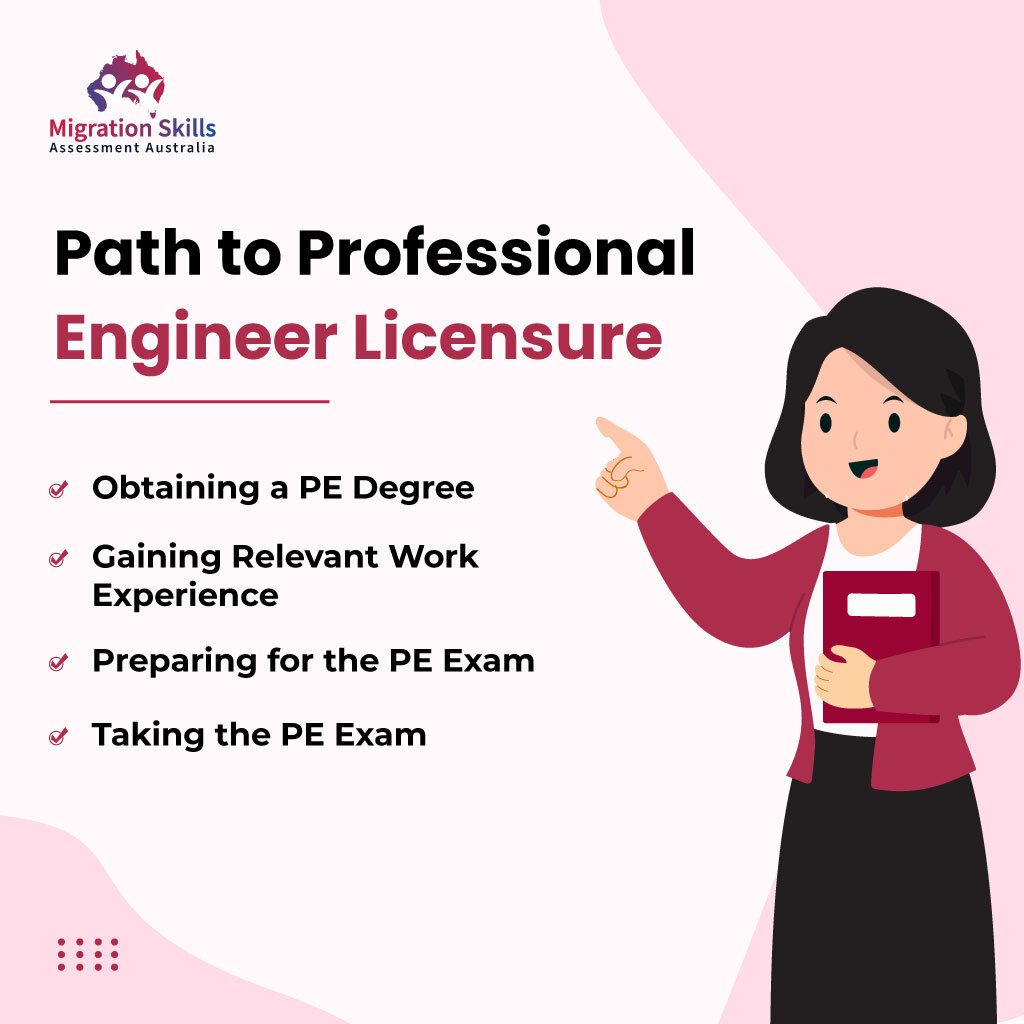How to become a licensed professional engineer in Australia?

How to become a licensed professional engineer in Australia?
Becoming a licensed professional engineer is a remarkable achievement that reflects an engineer’s technical expertise, competence, and unwavering commitment to upholding the highest engineering standards essential for securing permanent residency.
Obtaining a professional engineer (PE) license involves completing rigorous education, gaining relevant work experience, and passing the PE exam, a comprehensive assessment of an engineer’s knowledge and capabilities.
This comprehensive guide will delve into the journey of becoming a licensed professional engineer, the importance of PE licensure, the significance of passing the PE exam, and the steps involved in obtaining a PE license. We will also discuss the requirements and considerations for obtaining a PE license in various regions, including the United States.
What is a Professional Engineer?
A professional engineer is an individual who has successfully met the education, experience, and examination requirements set forth by the licensing board or regulatory authority like Engineers Australia in their respective region.
Professional engineers possess a degree in engineering from an accredited university, have acquired relevant work experience under the supervision of a licensed engineer, and have successfully passed the PE exam. They are responsible for designing, analyzing, and implementing engineering projects that adhere to industry standards, codes, and regulations.
Professional engineers are crucial in society, impacting public safety, health, and welfare. They are involved in various engineering disciplines, including Civil Engineering, Mechanical Engineering, Electrical Engineering, Chemical Engineering, and others.
Significance of PE Licensure
PE licensure is a critical milestone in an engineer’s career, as it legally recognizes their competency and expertise. With a PE license, an engineer gains the authority to independently sign and seal engineering documents, making them legally responsible for the safety and accuracy of their designs.
This level of responsibility underscores the significance of PE licensure, as it demonstrates an engineer’s ability to safeguard the public’s well-being and adhere to ethical and professional standards.
PE licensure also opens up opportunities for career advancement, as many engineering roles, especially in the public sector or those involving government contracts, require a licensed PE. Additionally, holding a PE license may lead to higher earning potential and increased credibility among peers and clients.
Pathway to Professional Engineer Licensure

1. Obtaining a PE Degree
Becoming a professional engineer involves pursuing a Bachelor’s degree in engineering or a related field from an accredited university. The specific engineering discipline chosen will depend on the engineer’s area of interest and career goals. An engineering degree typically spans four years of study and includes a mix of theoretical coursework and hands-on laboratory experience.
2. Gaining Relevant Work Experience
After completing the engineering degree, aspiring professional engineers are required to gain several years of work experience under the supervision of a licensed engineer.
The duration of the required work experience varies by region and licensing authority but typically ranges from two to four years. During this time, engineers apply their theoretical knowledge to real-world engineering projects, developing the practical skills necessary for the profession.
Work experience is a vital component of the licensure process, as it allows engineers to gain exposure to various engineering challenges, refine their problem-solving abilities, and understand the intricacies of project management and client interactions.
3. Preparing for the PE Exam
The PE exam is a comprehensive examination set by Department of Home Affairs that assesses an engineer’s knowledge and competence in their chosen engineering discipline. It is a significant step in the licensure process and typically includes morning and afternoon sessions.
The exam content is based on the fundamentals of engineering principles and practices specific to the chosen engineering discipline. Preparing for the PE exam is crucial to ensure success.
Engineers often invest significant time and effort studying and reviewing key concepts and exam topics. Review courses, practice exams, and study materials are commonly used to enhance preparation and familiarize candidates with the exam format.
4. Taking the PE Exam
Engineers must register and schedule the PE exam with the appropriate licensing board or regulatory authority. The PE exam is administered on specific dates each year and is offered in various locations. Candidates must plan and choose the exam date that aligns with their preparation timeline.
Read More: Skillselect Visa Categories: Which visa pathway is Right for You? ✈️✈️
Procedure of Professional Engineer Exam
1. Understanding the PE Exam
The PE exam is a standardized test to assess an engineer’s competency in applying engineering principles to real-world scenarios. It is a comprehensive examination that covers various topics relevant to the chosen engineering discipline. The exam format may vary by discipline but often consists of breadth and depth sections.
The breadth section covers general engineering principles, while the depth section focuses on specific topics within the chosen engineering discipline. The depth section allows candidates to demonstrate their specialized knowledge and expertise.
2. PE Exam Pass Rates
PE exam pass rates vary depending on the engineering discipline and the region where the exam is taken. Generally, the pass rates could be higher, making thorough preparation and focused study essential for success. The PE exam is challenging, but with diligent preparation, candidates can increase their likelihood of passing.
3. Preparing for the PE Exam
Engineers often invest in exam review courses and study materials to increase the chances of passing the PE exam. These resources help candidates review essential concepts, practice problem-solving, and become familiar with the exam format.
Working through sample problems and practice exams allows candidates to gain confidence in their abilities and identify areas that require further study.
4. Strategies for Success in the PE Exam
Successful PE exam takers often emphasize the importance of time management during the exam, staying calm and focused, and paying attention to details in problem-solving. To locate information quickly, it is essential to be well-versed with the reference materials allowed during the exam and be familiar with their content.
Read More: How to Become an Australian Permanent Resident? ✈️✈️
Obtaining the PE License
1. Professional Engineering Licensing Requirements
Engineers can apply for a PE license after successfully passing the PE exam and completing the required work experience. The licensing requirements vary by region and are established by the respective licensing boards or regulatory authorities. The process typically involves applying, providing proof of education and work experience, and paying the necessary fees.
2. Licensing Engineers – Regional Variations
Different regions and countries have licensing boards or regulatory authorities overseeing the PE licensure process. Engineers must adhere to the specific requirements and guidelines set forth by the respective boards in their region.
For example, in the United States, each state has its licensing board, and engineers must apply for a PE license in the state where they intend to practice. Some states have reciprocity agreements, which may allow engineers licensed in one state to obtain a license in another without retaking the PE exam.
3. Benefits of a PE License
A PE license offers numerous benefits to professional engineers. These benefits include increased career opportunities, the ability to work independently and take on higher levels of responsibility, higher earning potential, enhanced professional credibility, and the opportunity to work on projects with significant social impact, such as infrastructure development and public safety initiatives.
How Long Does It Take to Become a Professional Engineer?
Becoming a licensed professional engineer can take several years, depending on individual circumstances. It typically involves four main stages:
- Completing an engineering degree: This usually takes four years.
- Gaining work experience: Engineers typically require two to four years of relevant work experience, depending on the region and licensure requirements.
- Preparing for and passing the PE exam: Preparing for the PE exam may take several months, depending on the candidate’s study approach and schedule.
- Obtaining the PE license: The application processing time for the PE license may vary by region, but it typically takes a few months.
Therefore, the entire process of becoming a licensed professional engineer can range from six to ten years.
Visit: How to make an ideal CV for a skills assessment? 📑📑
What Degree Do You Need to Be a Professional Engineer?
To become a professional engineer, candidates must hold a Bachelor’s degree in engineering or a related field from an accredited university. The specific engineering discipline pursued will align with the candidate’s area of interest and chosen career path.
An engineering degree equips students with a strong foundation in mathematics, science, and engineering principles, providing them with the knowledge and skills necessary for engineering.
Pathways for Becoming a Professional Engineer
Becoming a professional engineer is a rewarding journey that requires a combination of education, experience, and examination. Obtaining a professional engineering license varies from region to region, but the fundamental pathways remain consistent.
This comprehensive guide will explore the critical steps in becoming a licensed professional engineer, from obtaining an engineering degree to passing the Principles and Practice of Engineering (PE) exam.
1. Obtain an Engineering Degree
The first foundational step to becoming a professional engineer is obtaining an engineering degree from an accredited university or college. Engineering is a diverse field with diverse specializations, including Chemical Engineering, Civil Engineering, Mechanical Engineering, Electrical Engineering, and many more.
Aspiring engineers typically choose a discipline that aligns with their interests and career goals. The engineering degree program typically spans four years and provides students with a comprehensive understanding of fundamental principles, mathematics, science, and specialized courses related to their chosen discipline.
The curriculum combines theoretical knowledge with hands-on laboratory experiences, allowing students to develop problem-solving skills and gain practical insights into engineering practices.
2. Gain Work Experience
After completing the engineering degree, aspiring professional engineers must gain practical work experience to apply their theoretical knowledge to real-world projects. The duration of required work experience varies depending on the region and the licensing board’s regulations.
In the United States, for example, most states require candidates to have at least four years of work experience under the supervision of a licensed professional engineer. During this period, candidates work as engineering interns or entry-level engineers, collaborating with experienced professionals on engineering projects.
This valuable experience allows them to witness the practical application of engineering principles, understand project management, and develop critical skills such as teamwork, communication, and problem-solving.
3. Pass the Fundamentals of Engineering (FE) Exam
Fundamentals of Engineering (FE) exam is the first step towards professional engineering licensure in many regions. Also known as the Engineer-in-Training (EIT) exam, it assesses a candidate’s understanding of fundamental engineering principles.
The FE exam covers topics common to various engineering disciplines, including mathematics, engineering economics, mechanics, thermodynamics, and electrical circuits.
The FE exam is typically a computer-based test, and its format may vary slightly depending on the region or country. Passing the FE exam demonstrates that a candidate has a solid foundation in engineering fundamentals and is eligible to progress to the next step of the licensure process.
4. Qualify the Principles and Practice of Engineering (PE) Exam
Principles and Practice of Engineering (PE) exam is the final step toward obtaining a professional engineering license. Unlike the FE exam, the PE exam is discipline-specific, focusing on the candidate’s chosen engineering specialization.
Passing the PE exam is a significant accomplishment, as it signifies that the candidate has the knowledge, expertise, and experience required to work independently as a professional engineer. The PE exam typically consists of both a morning and an afternoon session.
The morning session often includes questions that test general engineering principles and ethics, while the afternoon session concentrates on specific engineering topics related to the candidate’s chosen discipline. To qualify for the PE exam, candidates must meet the required educational and work experience criteria set forth by the licensing board in their region.
The work experience required varies depending on the region and the candidate’s education level. In some cases, candidates may be eligible to take the PE exam immediately after earning their engineering degree, while others may need several years of work experience before becoming eligible.
Read more: Engineering Jobs in Australia: A comprehensive list for Skills Assessment 📑📑
Seek Professional Advice from PE Exam Prep Providers
Preparing for the PE exam can be a challenging and time-consuming process. Many engineers seek guidance from PE exam preparation providers to enhance their chances of success.
These providers offer specialized study materials, review courses, and practice exams to help engineers prepare effectively for the exam. Additionally, some providers offer personalized coaching and support to address specific areas of difficulty and maximize study efficiency.
Conclusion
In conclusion, embarking on the journey to become a licensed professional engineer in Australia is a rewarding and transformative experience. From obtaining an accredited engineering degree to gaining invaluable work experience and passing rigorous exams, each step shapes an engineer’s expertise and prepares them to uphold the most significant standards in the profession.
As they navigate this path, aspiring professional engineers should remain steadfast in their dedication, continuously seeking knowledge and honing their skills. By joining the esteemed community of licensed professional engineers in Australia, they not only unlock exciting career opportunities but also contribute to the betterment of our world.
Remember, the journey does not end with licensure but marks the beginning of a lifelong commitment to excellence, integrity, and service as a trusted professional engineer. So, embrace the challenges, seize the opportunities, and engineer your future with pride and determination.
Your impact on society awaits, and the engineering landscape is ready for your innovative solutions and contributions. As licensed professional engineers, we forge toward a brighter, safer, and more sustainable tomorrow.


